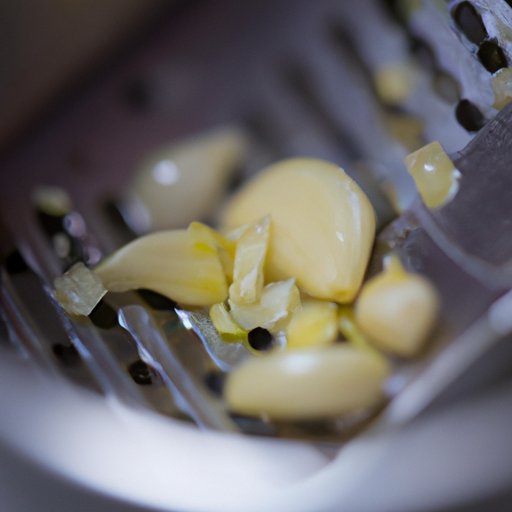Introduction
Garlic is an essential ingredient in many dishes, but its skin can be stubborn and hard to remove. Peeling garlic can take a lot of time and effort, and many people get frustrated with the process. However, there are several techniques that can make peeling garlic easier and quicker. In this article, we will explore different methods for peeling garlic and provide tips for doing it safely and efficiently.
The Traditional Method
The most common way to peel garlic is with a knife or by using your fingers. To peel garlic with a knife, place the garlic clove on a cutting board and lightly crush it with the flat side of the knife. This will loosen the skin and make it easier to remove. Then, use the edge of the knife to scrape off the skin.
When using your fingers, gently press down on the garlic clove with the flat side of a chef’s knife. The skin will loosen, and you can then use your fingers to peel it off. Be careful not to cut yourself when using a knife to peel garlic, and if you have sensitive skin, wear gloves to protect them.
The Shake and Peel Method
The shake and peel method is a simple and effective way to peel garlic. Place the garlic cloves in a container with a lid and shake it vigorously. The shaking action will cause the cloves to bump against each other, loosening the skin and making it easy to remove. You can use an empty jar, a plastic container with a lid, or a garlic peeler tube for this method.
When shaking, make sure to use a container with a lid and shake it hard enough to loosen the skin without damaging the garlic. Once the cloves are peeled, you can separate them from the skin by hand or with a small knife.
The Microwave Method
The microwave method is a quick way to peel garlic. Start by cutting off the root end of the garlic cloves, leaving the skin intact. Then, place them in a microwave-safe container and microwave them for about 20 seconds. This will heat up the garlic and loosen the skin, making it easy to remove.
Make sure not to overheat the garlic or leave it in the microwave for too long, as this will cook the garlic and make it bitter. Also, use oven mitts or a towel to handle the hot garlic after microwaving and peel it gently to avoid damaging the cloves.
The Water Method
Soaking garlic cloves in warm or hot water can also make peeling easier. Start by placing the cloves in a bowl and pouring hot water over them. Let them soak for a few minutes, then drain the water and let them cool down. The warm water will soften the skin, making it easier to remove.
Be aware that soaking the garlic for too long or in boiling water can cook it and affect its flavor. Make sure to pat dry the garlic after soaking to avoid getting water in your dish.
The Rolling Method
The rolling method involves using a rolling pin or hard surface to roll the garlic and peel off the skin. Start by placing the garlic cloves on a hard surface, such as a cutting board, and pressing down on them with a rolling pin or the flat side of a chef’s knife. The rolling action will crush the garlic and loosen the skin, making it easy to remove.
Make sure not to apply too much pressure when rolling the garlic, or you could damage the cloves. A plastic cutting board or silicone mat can help protect the garlic and prevent it from sticking to the surface as well.
The Roasting Method
Roasting garlic in the oven can enhance its flavor and make peeling it easier. Start by cutting off the top of the garlic head and drizzling it with olive oil. Wrap it in aluminum foil and bake it in the oven at 400°F for about 30-40 minutes, or until the garlic cloves are soft to the touch.
After roasting, let the garlic cool down before handling it. Then, gently squeeze the individual cloves to release them from the skin.
The Boiling Method
Boiling garlic cloves for a few minutes can also make peeling easier. Place the garlic cloves in a pot of water and bring it to a boil. Let it simmer for 2-3 minutes, then remove the pot from the heat and let the garlic cool down. Once cool, gently peel the skin off the cloves.
Make sure to use enough water to cover the garlic and not to boil it for too long, or you could overcook the cloves and affect their texture.
Conclusion
Peeling garlic is an important step in many recipes, but it doesn’t have to be a difficult or time-consuming process. By using one of these six methods, you can make peeling garlic easier and quicker. Whether you prefer the traditional method with a knife or the shake and peel method with a container, these techniques will help you get the job done. Remember to stay safe when using a knife or boiling water, and always handle hot garlic with caution.
Peeling garlic is an essential skill for any home cook, and these methods will make the task much easier. Try out each method and see which one works best for you.
